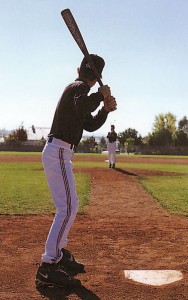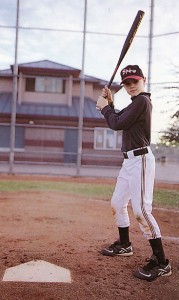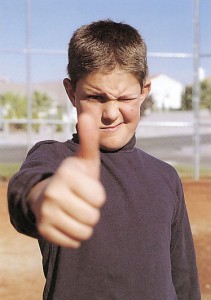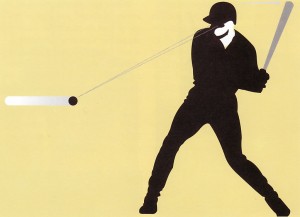The Three Batting Stances and Vision

As it relates to your stance, seeing the ball better means how you initially stand in the batter’s box to look out at the pitcher. There are basically three different types of stance. The neutral stance is one where your feet are square to the plate. This means that they are an equal distance from the plate. A stance like this affords you a good, comfortable look at the pitcher without straining yourself or otherwise becoming uncomfortable in the batter’s box. Most Major League hitters use a neutral stance. Ken Griffey, Jr., for one. Remember, we are only talking about how you place your feet in the batter’s box. We want to build that solid foundation from the ground up.
 The second stance, and also a very popular one with Major League hitters, is the closed stance. On the closed stance, the foot closest to the pitcher’s mound is placed slightly closer to home plate than the other foot. The key word here is slightly. You can overdo most anything, and getting too closed with your stance will definitely hamper your hitting. The great Tony Gwynn believes this is probably the best stance for most hitters.
The second stance, and also a very popular one with Major League hitters, is the closed stance. On the closed stance, the foot closest to the pitcher’s mound is placed slightly closer to home plate than the other foot. The key word here is slightly. You can overdo most anything, and getting too closed with your stance will definitely hamper your hitting. The great Tony Gwynn believes this is probably the best stance for most hitters.
 The open stance is just the opposite. The foot closest to the mound is pulled away from home plate. Jay Buhner of the Mariners is one of the more notable hitters that uses the open stance. Fewer Major League hitters use this stance, because of the obvious distance it takes you from the hitting zone. An open stance requires you to do more during the time the pitch is on its way to the plate, in order to get in the proper hitting position. More on that later.
The open stance is just the opposite. The foot closest to the mound is pulled away from home plate. Jay Buhner of the Mariners is one of the more notable hitters that uses the open stance. Fewer Major League hitters use this stance, because of the obvious distance it takes you from the hitting zone. An open stance requires you to do more during the time the pitch is on its way to the plate, in order to get in the proper hitting position. More on that later.
So, which stance is right for you? Well, each one has its advantages. Before you choose one though, I’d like you to take a little test. Because it is important to see the ball well, we need to find out which of your eyes is the dominant eye. The dominant eye is the one that does the majority of the work when you look at something. It sends the messages to the brain about where the ball is as it relates to the space around you. Your other eye does the same thing, but your dominant eye sends more precise information. Remember, you want every advantage on your side, not the pitcher’s.
 Extend your hand out in front of you with your thumb up as though you are giving a friend the “thumbs up” or “good job, way to go,” sign. With both eyes open, pick an object about twenty feet away from you and position your thumb so that the end of it covers that object. Now, close your left eye. Did your thumb seem like it moved over to the left? If it did, your left eye is your dominant eye. If nothing happened and your thumb is still covering the object, close your right eye. Did your thumb seem to have jumped over to the right? If so, your right eye is the dominant eye.
Extend your hand out in front of you with your thumb up as though you are giving a friend the “thumbs up” or “good job, way to go,” sign. With both eyes open, pick an object about twenty feet away from you and position your thumb so that the end of it covers that object. Now, close your left eye. Did your thumb seem like it moved over to the left? If it did, your left eye is your dominant eye. If nothing happened and your thumb is still covering the object, close your right eye. Did your thumb seem to have jumped over to the right? If so, your right eye is the dominant eye.
Why is all of this important to you? The answer is simple, you want to make use of your dominant eye when you are hitting. Choosing the proper stance to help put that dominant eye to work is important. Ideally, your dominant eye would be the one closest to the pitcher. The left eye for the right handed batter, the right eye for the left handed batter. Unfortunately, most people are just the opposite. Right handed batters generally are right eye dominant and vice-versa.
Having your dominant eye closer to the pitcher contributes to better tracking of the ball to the hitting zone. This is one of the factors that helps explain why switch hitters hit better from one side or the other. Not having this luxury does not mean you can’t be a good hitter.
What it means is, by knowing which eye sends the more precise messages to the brain, you should position yourself so that you see the ball with that eye.
 This is the reason most Major League hitters choose the neutral position as their stance of choice. I doubt, however, that many of them consciously know which of their eyes is dominant. It probably came about from years of trial and error and they finally settled on that position because they felt they saw the ball better. You can wipe out years of trial and error just by knowing which of your eyes sees the ball better! From the neutral stance, you can position your head comfortably enough over your front shoulder to use both eyes to see the ball, bringing your dominant eye into play. This is known as binocular, using both eyes.
This is the reason most Major League hitters choose the neutral position as their stance of choice. I doubt, however, that many of them consciously know which of their eyes is dominant. It probably came about from years of trial and error and they finally settled on that position because they felt they saw the ball better. You can wipe out years of trial and error just by knowing which of your eyes sees the ball better! From the neutral stance, you can position your head comfortably enough over your front shoulder to use both eyes to see the ball, bringing your dominant eye into play. This is known as binocular, using both eyes.
Obviously, the open stance gives you an even greater use of both eyes. The reason it is not employed as often by great hitters, is that the trade off for good vision and the increased amount of things you need to do to get in the proper hitting position is simply not worth it. The less complicated your swing is, the more successful you are apt to be. Again, more on this later.
The closed stance has advantages. If you can comfortably position your head over the front shoulder to utilize the vision from both eyes, you can take advantage of the increased plate coverage you get from this stance. Stan Musial, one of the great hitters of all time, used a slightly closed stance. If you were to look at him from the pitcher’s mound during his stance, you might think his neck was made of rubber his head was turned so far over his front shoulder. Needless to say, he saw the ball very well, and he hit the ball very well.
To sum this section up; since we are building a good hitter a little at a time, pick a stance that affords you the best opportunity to see the ball well. Taking into consideration which of your eyes sends the more accurate messages to the brain. You need to give that computer up there the proper information if you want to be successful at one of the more difficult physical acts in sports.

I was right with you until your rather disappointing conclusion. Straight logic would dictate if a player is right eye dominate but also bats right, he should use an open stance to see the ball better with their dominant eye NOT being the one closest to the pitcher. That’s the logical conclusion of your argument, but then you fudged it with “more movement and complexity”. Comment?
Actually, the test explaining how to decide which is eye is dominant is wrong. The eye open when the target doesn’t move, is you dominant eye.
Sorry I misread it But I bat left-handed and I’m right eye dominant so therefore my dominant eye is closer to the pitcher, That’s the point I meant to make I apologize.
If you were much of a hitter, you would understand perfectly why movement during your swing would offset any advantage you might have by opening your stance.